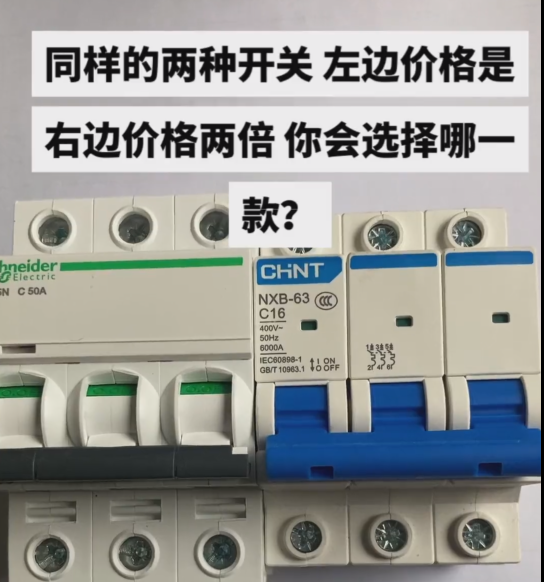Why is there a big price difference between Chint and Schneider 3PC15 circuit breakers?

The price difference between Chint and Schneider 3PC15 circuit breakers is the result of the comprehensive influence of multiple factors from various dimensions, such as technological research and development, brand positioning, material technology, and market strategies. The following analysis is carried out from six key dimensions:
Technological Research and Development and Patent BarriersSchneider Circuit Breakers Price
As a global leader in low-voltage electrical appliances, Schneider invests far more in research and development in core technology fields than Chint. It has already owned 1,013 patents in the Chinese mainland (as of 2019), covering fields such as intelligent hardware, software systems, and digital services. For example, Schneider's EcoStruxure platform integrates AI-driven process safety analysis technology, which can enhance industrial safety performance by automatically simulating potential hazard scenarios. Although Chint has strong research and development capabilities in the domestic market, there is still a gap between the number of its patents (approximately 2,500 - 2,600 pieces) and the technical complexity compared to Schneider.Chint's NB1-63DC series DC circuit breakers Price
Specifically for the 3PC15 circuit breaker, Schneider may adopt more advanced arc extinguishing technology (such as magnetic blowout arc extinguishing) and contact materials (such as silver cadmium oxide), achieving higher breaking capacity (for example, 100kA vs. Chint's 60kA) and supporting operation in a wide temperature range (-40℃~70℃). These technological innovations directly increase the production cost.
Material Technology and Manufacturing Standards
Schneider implements stricter standards in material selection and manufacturing processes:Chint NXR series thermal overload relays price
- **Housing Material**: Schneider uses 304 stainless steel or high-strength flame-retardant PC material (UL94 V-0 grade), while Chint may use cold-rolled steel plates or ordinary engineering plastics.
- **Contact System**: The contact plating thickness of Schneider reaches 3μm (gold-plated), while that of Chint is usually 1μm (tin-plated), resulting in differences in electrical conductivity and corrosion resistance.CHINT contactor price
- **Production Process**: Schneider's automated production line adopts laser welding (weld seam accuracy ±0.1mm) and AI visual inspection, with a yield rate of 99.5%. In contrast, Chint has a higher proportion of manual intervention, with lower production costs but slightly lower efficiency.
In addition, Schneider's products need to pass international certifications such as UL, CE, and ATEX, while Chint mainly complies with GB standards. The difference in certification costs accounts for about 15% of the product price.CHINT surge protector price
Brand Premium and Market Positioning
Schneider maintains a premium through its high-end brand image and industry benchmark effect:
- **Industry Status**: Schneider has the highest market share in high-end markets such as industrial projects and data centers, while Chint has more advantages in civil and small and medium-sized commercial fields. Schneider LRD Thermal Relay Price
- **Brand Value**: Schneider's global brand premium rate is approximately 30%, while as a domestic leader, Chint's premium rate is only 10%-15%.
- **Service Network**: Schneider's global service network covers 150 countries, providing 7×24-hour technical support, while Chint's services are mainly concentrated in the domestic market.
Functional Integration and Intelligence Level
Schneider 3PC15 may integrate more high-end functions:
- **Intelligent Monitoring**: It supports communication protocols such as MODBUS and BACnet and can be connected to the SCADA system to achieve real-time monitoring of current and voltage.
- **Energy Management**: Through the EcoStruxure platform, it analyzes energy consumption data and optimizes power distribution, while similar products of Chint usually only have basic protection functions.
- **Expansion Capability**: Schneider's modular design supports flexible configuration (such as adding a surge protection module), while Chint's expandability is relatively limited.
These functional differences increase the added value of Schneider's products by approximately 20%-30%.
Distribution Channels and Cost Structure
Schneider's distribution network has more levels, which increases the terminal price:
- **Channel Mode**: Schneider adopts a four-level distribution model of "manufacturer-regional agent-dealer-user", and the channel cost accounts for about 25%. In contrast, Chint adopts a three-level model of "manufacturer-county-level agent-user", reducing the cost by 10%.
- **Bulk Purchasing**: Chint reduces the marginal cost through large-scale production (producing over 100 million circuit breakers annually), while Schneider's high-end product line has a smaller output, resulting in a higher unit cost.
- **After-sales Service**: Schneider provides a 1-year warranty, while Chint provides a 2-year warranty. However, Schneider's global warranty service has a wider coverage.
Market Strategies and Competitive Environment
Schneider consolidates its high-end market through a differentiation strategy:
- **Price Anchoring**: The price of Schneider 3PC15 is usually 2-3 times that of Chint, forming a "high-end-middle-end" market segmentation to avoid direct competition with Chint.
- **Industry Barriers**: In fields such as petrochemical and nuclear power, Schneider establishes technical barriers with explosion-proof certification (Ex d IIB T6) and industry standards (such as API 6A), while Chint has a low penetration rate in these fields.
- **Local Cooperation**: Schneider covers the middle-end market through a joint venture with Delixi (Delixi Electric) to avoid brand image conflicts, while Chint squeezes the low-end market through price wars.
Comparison of Typical Cases
| Brand | Component Cost | Box Cost | Labor/Taxes | Total Price | Premium Rate |
| Chint | WA:0086-13811255435 | Benchmark | |||
| Schneider | 106% | ||||
The price difference mainly comes from Schneider's high-end components (such as intelligent circuit breakers), stainless steel boxes, and brand premiums.
Conclusion
The choice between Chint and Schneider should be based on the application scenario and budget:
- **Industrial-level Requirements**: Schneider has obvious advantages in reliability, intelligent functions, and international certifications, making it suitable for scenarios such as data centers and petrochemical plants.
- **Civil/Small and Medium-sized Commercial Use**: Chint becomes the mainstream choice due to its cost-effectiveness and localized services.
- **Long-term Cost**: Schneider's high price can be amortized through a lower failure rate and a longer service life, while Chint is more suitable for budget-sensitive users.
By comparing technical parameters (such as breaking capacity and certification standards) and analyzing functional requirements, users can make a more reasonable choice.


